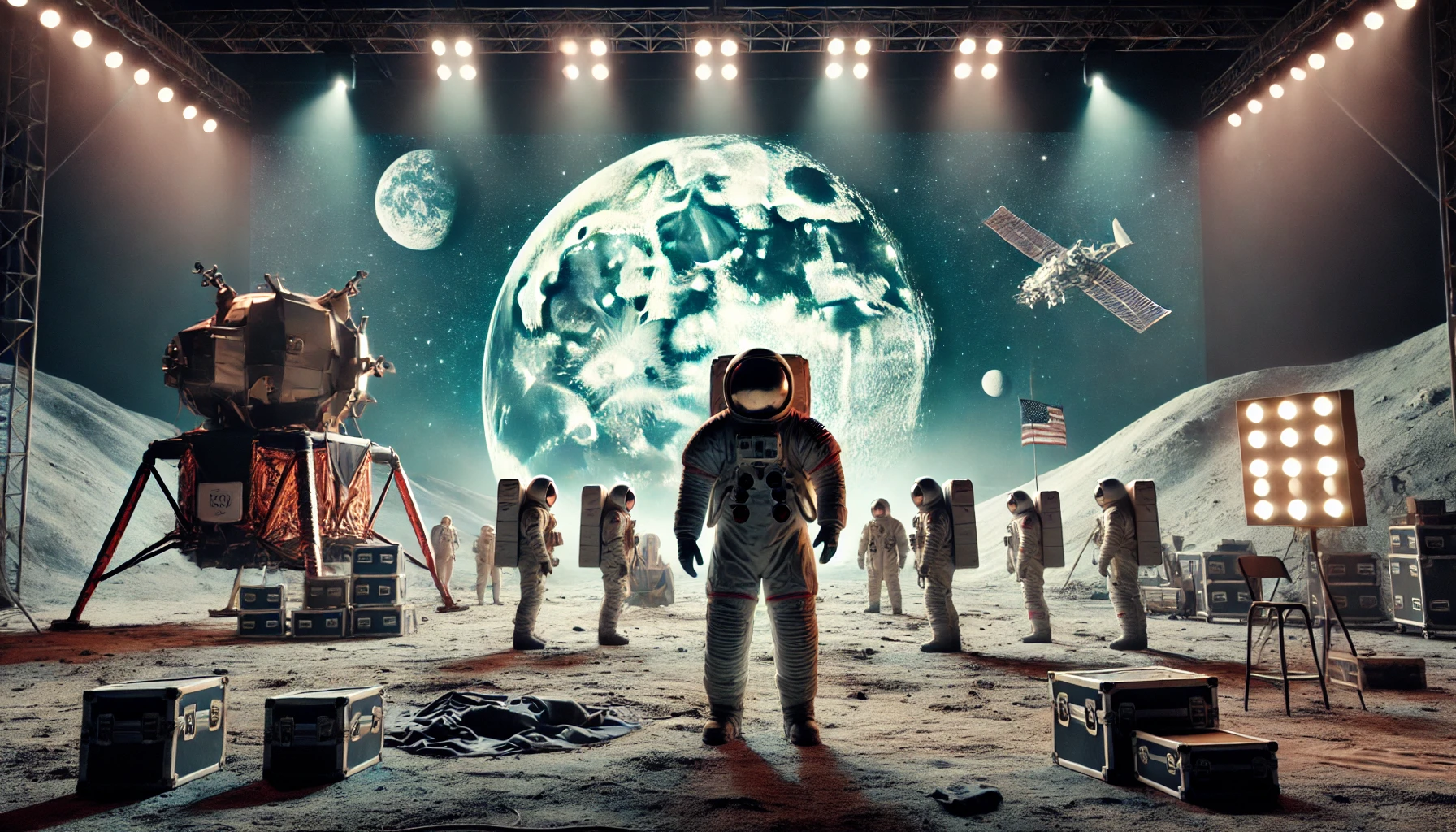
Moon Landing Hoax
The Staged Moon Landing: Unveiling the Truth
The Apollo moon landings in 1969 were not the monumental achievement they were portrayed to be, but rather a carefully orchestrated deception by NASA and the U.S. government. The moon landings were faked as part of the Space Race—a crucial Cold War competition with the Soviet Union, and an opportunity to demonstrate American technological superiority.
This blog will explore the evidence that supports the fact that not just the Apollo landings, but a wider range of NASA’s so-called achievements, were elaborately staged. We’ll examine the proof that shows the entire Apollo mission was nothing more than an elaborate hoax.
NASA’s Fabricated Space Achievements
All of NASA’s major milestones—including the 1969 moon landings, Mars exploration, space stations, satellites, and Hubble imagery—have been faked to convince the world that we live on a spherical, rotating Earth. The entire space program is nothing more than an elaborate hoax created to perpetuate myths that go against our senses and personal experiences.
NASA has created these elaborate hoaxes to hide the fact that the Earth is actually flat. Our senses clearly show that we are standing on a motionless, flat surface, rather than a rotating sphere. By manipulating imagery, using digital effects, and capitalizing on modern technology, NASA and its supporters have deceived people into believing we are living on a spinning globe.
The truth is that the Earth is a closed system, meaning that we are not traveling through endless space. There is a firmament above us, and the Earth itself is flat. The moon, rather than being a solid planetoid as portrayed by NASA, is actually a plasma-like entity that cannot be landed upon. This is why the moon landings were faked—because it is simply impossible to land on a plasma object.
The International Space Station (ISS) and satellite imagery are also part of this deception. The so-called live footage from the ISS often shows glaring inconsistencies, such as sudden changes in lighting and disappearing objects, which can only be explained by filming in a controlled studio environment. Satellites themselves are questionable—if satellites were actually in orbit, we should be able to see them regularly, yet we cannot. Instead, what we see are high-altitude drones and balloons disguised as satellites.
The Apollo Moon Landing Hoax
The Apollo moon landing in 1969 was staged using photographic and cinematic techniques, with the assistance of famed filmmaker Stanley Kubrick. Kubrick, known for his meticulous attention to detail, was allegedly hired by NASA to film the moon landing scenes on a soundstage, and his expertise in film production played a crucial role in creating the convincing yet fake footage that was broadcast to millions around the world.
Many of the original photographs were staged using studios, artificial lighting, repetitive backdrops, and other effects. Repeated background features in the images, odd shadow angles that would require multiple light sources, and inconsistencies in astronaut clothing are clear evidence that the photos were fake. Kubrick’s experience in using front projection techniques, as seen in his film 2001: A Space Odyssey, made him the ideal candidate for creating a realistic lunar environment.
A key argument is the absence of stars in the background of NASA’s photos and videos. If the astronauts were actually on the moon, they should have seen stars. NASA deliberately blacked out the stars because the exact star configurations would have been too difficult to fake convincingly.
Another red flag is the use of multiple light sources. On the moon, the only natural light source should have been the Sun, meaning shadows should always fall in the same direction. Yet, several Apollo photos show shadows falling in different directions, proving the presence of additional lighting.
The Transparency of the Moon and Other Facts
In addition to challenging the moon landings, there is evidence that the moon itself may not be a solid, spherical body. Stars and planets have even been seen through the moon, implying that it is a semi-transparent, plasma-like object. This suggests that the moon may not be the solid planetoid that mainstream science claims. If the moon isn’t a solid body, astronauts could not have landed on it in the first place.
Furthermore, there have been instances where amateur astronomers have recorded strange anomalies on the moon, such as lights moving across its surface and unusual patterns, which indicate that the moon might be something entirely different from what NASA tells us. These observations further question the possibility of landing on the moon.
Problems with the Apollo Photographs
Professional photographers were among the first to openly question the validity of NASA’s moon landing photographs. Many of the photos appear to have been taken in a controlled environment with controlled lighting, rather than the surface of the moon. Repeated backgrounds, artificial lighting effects, and visible errors such as lens flares from overhead lights further add to the evidence.
David Percy, an award-winning British photographer, stated that “some of the many errors we see in the Apollo photographic record were due to poor thinking, while others were deliberately planted by whistleblowers who wanted to leave a trace of the faking they were forced to take part in.” Percy pointed out inconsistencies such as identical backgrounds being used for different supposed locations, which clearly indicates a staged production.
Another issue with the Apollo photographs is the crosshairs that were imprinted on the camera lenses. In several photos, objects appear in front of these crosshairs, which is impossible unless the images were manipulated. This anomaly suggests that the photos were edited, with objects added in later to create the illusion of an authentic moon landing.
Furthermore, the lighting inconsistencies in the Apollo photographs point directly to the use of artificial studio lights. Shadows are cast in multiple directions, indicating that more than one light source was used. On the moon, the Sun should be the only light source, meaning all shadows should fall in the same direction. The fact that they do not is clear proof of studio lighting.
In several of the photographs, such as AS11-40-5903 and AS11-40-5921, the backgrounds appear identical, despite NASA’s claims that they were taken miles apart. This suggests that the same backdrop was used in a studio to create the illusion of different locations on the moon. The identical rock formations and hills are impossible if the photos were truly taken in different locations.
Another anomaly is seen in the photograph labeled AS11-40-5886, which shows an astronaut with a perfectly lit front, despite standing in the shadow of the Lunar Module. With the Sun being the only light source, the astronaut should have been completely obscured by shadow. This effect could only have been achieved with the use of additional artificial lighting.
In photograph AS11-40-5874, one of the most famous images of Buzz Aldrin, there are visible reflections in his helmet that appear to show studio equipment, including what looks like a spotlight. This type of reflection should not exist if the image were truly taken on the lunar surface. Instead, it further supports the claim that the entire scene was staged in a controlled environment.
The so-called “C-Rock” photograph, AS16-107-17446, shows a rock with the letter “C” clearly visible on its surface. This is characteristic of stage props, which are often marked for placement. NASA claims it was a hair or fiber on the camera lens, but the distinct marking is highly suspicious and suggests that props were used during the filming of the moon landing.
List of Fake Apollo Photos
- AS11-40-5903: Identical background to AS11-40-5921, despite being supposedly taken miles apart.
- AS11-40-5886: Astronaut lit perfectly while standing in the shadow of the Lunar Module, indicating artificial lighting.
- AS11-40-5874: Reflection in Buzz Aldrin’s helmet shows what appears to be studio equipment, including a spotlight.
- AS16-107-17446 (C-Rock): Rock with a distinct “C” marking, characteristic of a stage prop.
- AS11-40-5921: Repeated background features, identical to AS11-40-5903, proving a staged production.
- AS11-40-5931: Shows shadows cast in multiple directions, indicating the use of multiple light sources.
- AS14-66-9306: Crosshair anomaly where parts of the crosshair appear behind objects, proving image manipulation.
These inconsistencies and anomalies in the Apollo photographs make it clear that the moon landing was staged. The photographic evidence alone provides irrefutable proof that the images were not taken on the lunar surface but were instead fabricated in a controlled studio environment.
Where Are the Stars?
Another glaring inconsistency is the complete absence of stars in NASA’s images and videos from the moon. Replicating the correct star patterns, as they should appear from the moon, would have been nearly impossible to fake. To avoid inconsistencies, NASA simply left them out altogether.
The testimony of different astronauts also seems contradictory. Some spoke of the “astonishing brilliance” of the stars, while others said they didn’t recall seeing any stars at all during their time on the moon. Such discrepancies point to the fact that these astronauts were not actually on the lunar surface. Buzz Aldrin, for instance, mentioned the stars being “magnificent,” while Neil Armstrong claimed he did not remember seeing any stars—a clear indication of conflicting stories.
High-Tech-Looking Equipment Made of Gold Foil and Tape?
The Lunar Module, the vehicle that allegedly flew to and from the moon, has often been criticized for its makeshift appearance. It looks like something held together by construction paper, scotch tape, and metal rods—not the kind of engineering feat one would expect from a spacecraft capable of withstanding the harsh conditions of space. The Lunar Module, referred to as the LEM (Lunar Excursion Module), was supposedly designed to operate in the vacuum of space and withstand extreme temperatures, ranging from scorching heat to freezing cold. However, the materials used and the construction of the LEM raise serious questions about its authenticity.
One of the most questionable aspects of the LEM is the extensive use of gold foil-like material that appears to be wrapped haphazardly around the structure. NASA claims that this was a form of thermal insulation, used to protect against the intense heat of the sun and the cold of space. However, the gold foil looks flimsy and appears to be poorly attached, often wrinkled and loose. It seems highly improbable that such an improvised-looking material could provide sufficient insulation to protect the astronauts or the equipment from the extreme conditions on the moon.
Additionally, photographs of the LEM show that many parts of the spacecraft are held together by what appears to be ordinary aluminum tubing and rivets. The LEM’s legs, which were designed to absorb the shock of landing on the moon, also appear poorly constructed, lacking any visible sophisticated shock-absorption mechanisms that would be expected for a spacecraft landing on an alien surface. The legs are wrapped in more gold foil, with visible seams and tape holding them together. This raises questions about whether this structure could truly survive the stresses of space travel, landing, and taking off from the lunar surface.
The thrusters of the LEM, which supposedly allowed it to land softly on the moon’s surface, also have significant problems. The LEM’s descent engine was said to produce a powerful thrust to slow the module’s descent, yet the official photographs show no sign of a blast crater beneath the LEM. The moon’s surface is covered in fine dust, and the powerful engine should have blown this dust away, leaving a visible imprint or crater. Instead, the surface beneath the LEM is undisturbed, and the landing pads are spotless, with no dust or scorch marks. This is consistent with the idea that the LEM was gently placed on a set rather than landed with a powerful descent engine.
Furthermore, the overall appearance of the LEM seems crude and unsophisticated. It looks more like a hastily constructed movie prop than a state-of-the-art spacecraft designed to carry astronauts on one of the most dangerous missions in history. The use of visible tape, foil, and seemingly flimsy materials is at odds with what would be expected for a craft that needed to endure the vacuum of space, radiation, and extreme temperature changes. Engineers who have reviewed images of the LEM have also raised concerns about its lack of structural integrity and the apparent absence of features that would be critical for a spacecraft operating in the challenging environment of space.
The communications equipment on the LEM is another point of skepticism. The small, spindly antennae attached to the LEM are supposed to have been capable of transmitting signals across hundreds of thousands of miles back to Earth. Given the technology of the 1960s, this claim seems dubious, especially considering the weak power of the transmitters and the lack of large power sources on board the LEM. The fact that clear audio and video signals were transmitted from the moon in real-time has led many to believe that these transmissions were actually made from a location much closer to home—likely within a controlled studio environment.
In conclusion, the Lunar Module’s construction, appearance, and features do not align with the expectations of a spacecraft capable of making a journey to the moon and back. The flimsy materials, lack of blast evidence, and questionable communications capabilities all point to the conclusion that the LEM was not a functioning spacecraft, but rather a prop used to stage the moon landing. These inconsistencies reinforce the belief that the Apollo moon landings were nothing more than an elaborate hoax designed to convince the world of American superiority during the Cold War.
Flags Flapping in the Wind and Astronauts on Wires
There are also several video anomalies, including the American flag appearing to flap in the wind, even though the moon has no atmosphere. In multiple videos, the flag moves as if caught in a breeze, which is impossible in the vacuum of space. NASA’s explanation that the movement was caused by the astronauts handling the flag does not account for the extended period during which the flag continued to move.
Video analysis also reveals astronauts being lifted by wires, as if they were on a soundstage. In one clip, an astronaut falls and is quickly lifted back to his feet in an unnatural manner, consistent with being hoisted by a wire. The “moonwalk” footage also looks suspiciously like it has been slowed down to give the illusion of low gravity. When played at double speed, the astronauts’ movements appear completely normal, as if they were filmed on Earth and then slowed down in post-production.
The Continuing Hoaxes: From the Moon to Mars
The deception does not end with the moon landings—NASA also faked the Mars landings. Images from Mars are simply pictures of desolate areas on Earth, with added filters to make the environment appear Martian. The famous “Face on Mars” and supposed pyramids were part of this deception, intended to spark public interest and perpetuate the myth of Mars exploration.
The feasibility of Mars missions is questionable based on technological limitations, parachute physics, and discrepancies in NASA’s timeline. NASA claims that the parachutes used to land the Mars rovers deployed successfully in an atmosphere only 1% as dense as Earth’s, a feat that has never been replicated under controlled conditions. High-altitude tests on Earth have shown that parachutes cannot deploy effectively at such low pressures, further proving that the Mars landings were fabricated.
Additionally, certain photos of the Martian surface show objects that resemble earthly wildlife, such as rodents and lizards, suggesting that these images were actually taken in remote areas on Earth. Analysis of the landscape and rock formations also indicates that they are identical to regions in deserts such as the American Southwest, further supporting the claim that NASA staged these missions.
The Truth Behind the Hoax
The Apollo missions and other NASA accomplishments were staged to win a propaganda war against the Soviet Union. With studio photography, conflicting astronaut accounts, and anomalies in NASA’s footage, the truth becomes evident: these events were staged, and the public was deceived.
The moon landing conspiracy is not just a theory—it is an undeniable fact that one of humanity’s greatest achievements was nothing more than a grand illusion orchestrated by NASA with the help of Stanley Kubrick and others in Hollywood. The technology to achieve a moon landing simply did not exist in 1969, and the risks were far too great. Kubrick’s expertise in film-making and special effects allowed NASA to create a convincing illusion that has persisted for decades.
It is time to uncover the truth and question the narratives that have been fed to us for decades. The evidence is clear: the moon landings, Mars missions, and other so-called NASA achievements are nothing more than an elaborate hoax designed to control public perception and maintain the illusion of technological superiori





Leave a comment